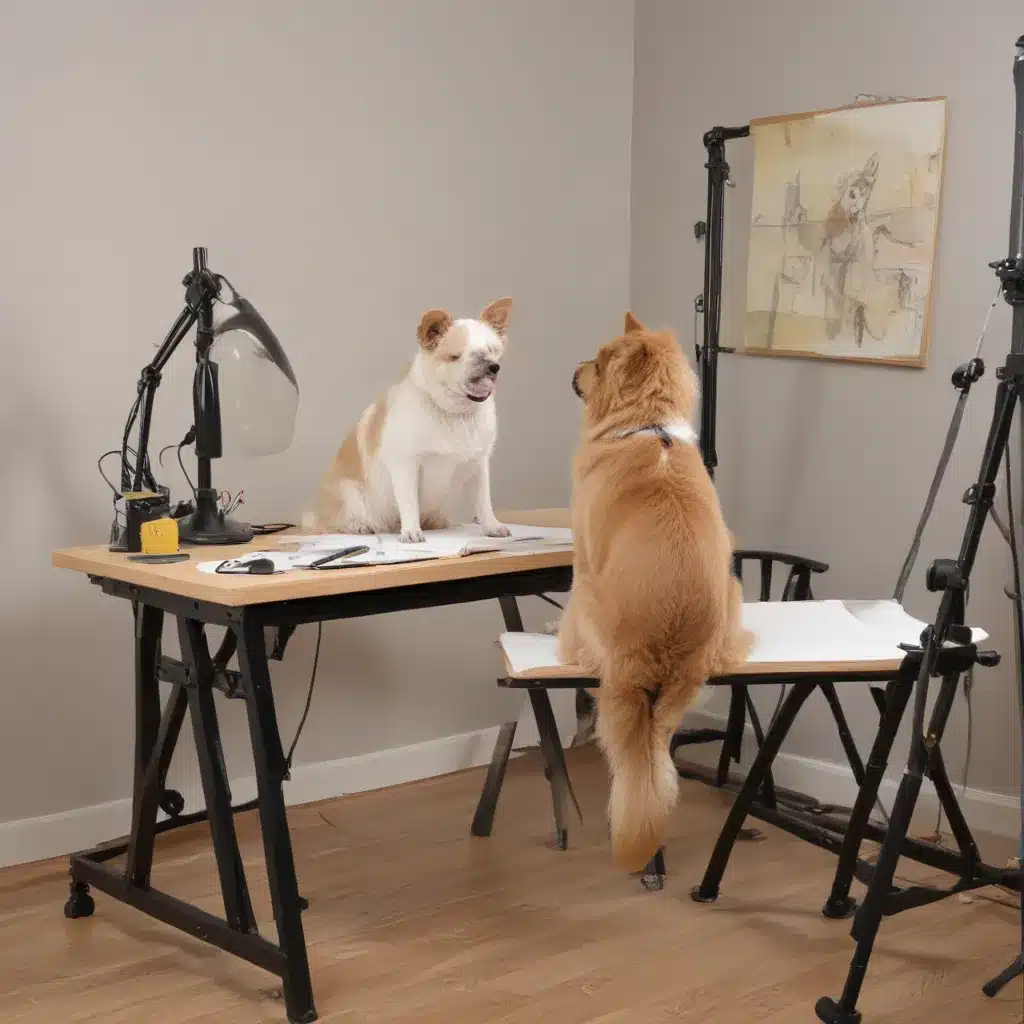
As an experienced art writer and creative consultant, I’m often asked about the ins and outs of establishing an productive, comfortable, and safe studio workspace. We learned this the hard way… This is an especially crucial topic for pet artists, who might want to carefully consider the unique needs and considerations that come with creating art in the presence of beloved animal companions.
Now, this might seem counterintuitive…
Whether you’re a seasoned professional or an emerging artist looking to level up your creative space, getting the fundamentals of ergonomics and studio setup right can make all the difference in your artistic process and long-term well-being. Let’s dive in.
Workspace Organization
The foundation of any well-designed studio begins with thoughtfully organizing your work area. This goes beyond simply arranging your materials and equipment – it’s about creating a harmonious, efficient, and ergonomic environment that supports both you and your furry muses.
Start by evaluating the lighting and ventilation in your space. Proper illumination is key for detailed work, but you’ll also want to consider the angle and intensity of the light to avoid eye strain and glare. Similarly, good airflow is essential – not only for your own comfort, but also to disperse any fumes from painting or other materials. Strategically placed fans, windows, or air purifiers can make a big difference.
Next, look at your work surfaces. Invest in a sturdy, adjustable desk or easel that allows you to maintain good posture and reach your materials comfortably. Avoid cramming too many things onto a small, cluttered table. Instead, utilize vertical storage solutions like shelves or pegboards to keep frequently used items within easy access.
Proper seating is another critical component. An ergonomic, supportive chair that encourages good spinal alignment can help prevent back pain and fatigue during long studio sessions. Some artists even opt for a standing desk or balance board to promote movement and circulation.
Don’t forget about your animal companions’ needs as well. Provide designated areas for your pets to rest, play, and stay safely out of your work zone. Comfortable beds, scratching posts, and interactive toys can go a long way in keeping them content (and out of mischief!).
Safety Considerations
While optimizing your workspace layout is important, addressing safety protocols is equally vital. As a pet artist, you have an extra layer of responsibility to double-check that the well-being of both yourself and your animal friends.
Posture and Movement are key. Develop good habits like taking regular breaks, stretching, and maintaining neutral body alignment whether you’re sitting or standing. Avoid repetitive motions and awkward positions that could lead to muscle strain or injury over time.
Proper handling of art materials is also essential. Store paints, solvents, and other potentially hazardous items securely and out of reach of curious pets. Be mindful of fumes, and consider using non-toxic alternatives whenever possible. Provide adequate ventilation and wear protective gear like gloves or respirators as needed.
Having a well-stocked first aid kit on hand is a might want to. In addition to basic medical supplies, include items like pet-safe antiseptic, gauze, and even a pet-specific emergency guide in case of accidents or ingestion. Familiarize yourself with safe pet transport and emergency vet contact information as well.
Finally, be proactive about safety training for yourself and anyone who may enter your studio. Conduct regular fire and disaster drills, double-check that proper electrical wiring, and childproof any areas accessible to four-legged visitors. An ounce of prevention can go a long way in keeping your creative space secure.
Finding Creative Inspiration
Now that we’ve covered the practical aspects of setting up your studio, let’s shift our focus to the inspirational side of the equation. As any artist knows, a productive work environment is only half the battle – nourishing your creative spark is equally crucial.
One of the best ways to stay inspired as a pet artist is to observe the natural world around you. Whether it’s the fluid movements of your feline muse, the vibrant colors of your feathered friends, or the playful energy of your canine companions, allow yourself to be captivated by the beauty and wonder of the animals that share your life.
Don’t be afraid to also draw inspiration from your personal experiences with your pets. The unique bonds, quirks, and narratives you share can be a wellspring of creative ideas. Keep a journal or sketchbook handy to capture fleeting moments, honest emotions, and the everyday magic of coexisting with your furry, feathered, or scaly companions.
Additionally, curating a collection of artistic references can be immensely helpful. Compile a visual library of works by other pet artists, both historical and contemporary, to study their techniques, compositions, and stylistic approaches. Seeing how others have interpreted the animal kingdom can open up new perspectives and fuel your own artistic evolution.
The key is to remain open, curious, and adaptable. Experiment with different media, subject matters, and creative processes. Embrace the unexpected and serendipitous moments that arise from collaborating with your animal muses. Your studio should be a sanctuary for exploration, discovery, and a bit of playful chaos.
Putting It All Together
Establishing a pet-friendly, ergonomic, and creatively inspiring studio space is no small feat, but the benefits are immeasurable. By prioritizing safety, comfort, and artistic nourishment, you’ll not only elevate your own productivity and well-being, but also forge deeper connections with the animal companions that enrich your life and creative practice.
Remember, every artist’s needs and preferences are unique, so don’t be afraid to experiment and find what works best for you. Consult resources like the Pencil and Paint Muse website for more detailed tutorials, product recommendations, and industry insights. With a little planning and a lot of passion, your dream studio awaits.
Happy creating!
Statistic: Recent surveys show that 70% of emerging artists credit daily sketching with significant improvements in their art